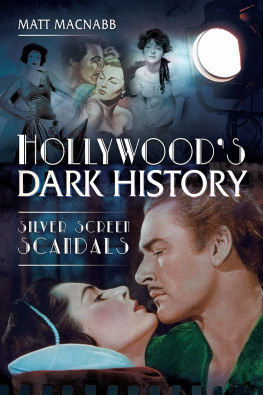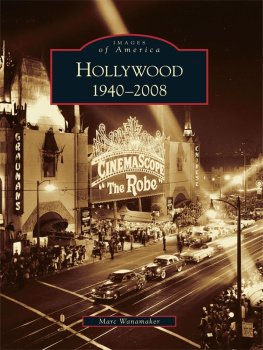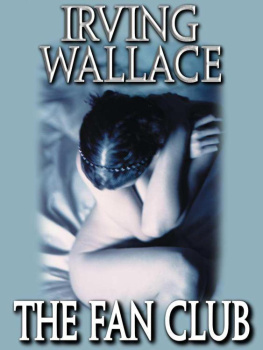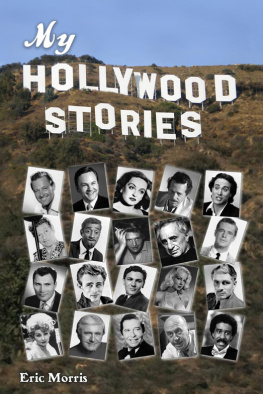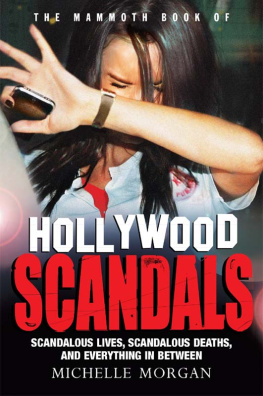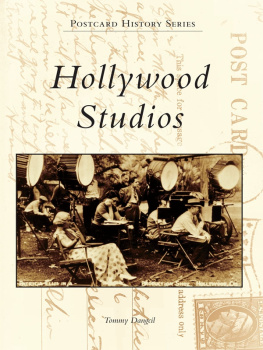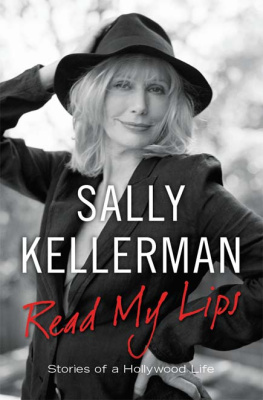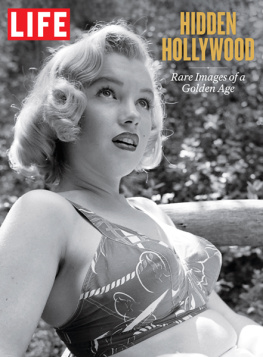To Steve Lopezyou will never know the impact you have had on my life, and on so many others. For my part, I will be forever grateful.
Thank you to Bruce Ryan and Craig Owens, to Stephanie Scott and Eugene Brissie. Without you, this project would not be what it is today. I thank you all from the bottom of my heart.
Para mi MamaQueen, you are an inspiration. I will always be proud of you and Ill continually strive to make you proud of me. Gracias para todo lo que haces.
Fito, Tanya, and all the little ones. Amos and Brianna. Aunt Laura. Juanita. Thank you for your unending support and love.
To my beautiful friends, you are truly indispensable. I love you all.
Brooks, Louise. Lulu in Hollywood. New York: Knopf Doubleday, 1983.
Clarke, Andra D., and Regina Denton-Drew. Ciros: Nightclub of the Stars. Charleston, SC: Arcadia Publishing, 2015.
Crane, Cheryl, and Cindy De La Hoz. Lana: The Memories, the Myths, the Movies. Philadelphia, PA: Running Press, 2008.
Crane, Cheryl, and Cliff Jahr. Detour: A Hollywood Story. Gettysburg, PA: Arbor House, 1988.
Croddy, Marshall, and Patrick Jenning. Testimony of a Death. Bay City Press, 2017.
Graham, J. H. Sunset Strip. J. H. Graham, 2020, www.jhgraham.com.
Hodel, Steve. Black Dahlia AvengerA Genius for Murder: The True Story. New York: Arcade Publishing, 2003.
Lewis, Judy. Uncommon Knowledge. New York: Pocket Books, 1994.
Mann, William J. Tinseltown: Murder, Morphine, and Madness at the Dawn of Hollywood. New York: HarperCollins, 2015.
Marx, Samuel, and Joyce Vanderveen. Deadly Illusions: Jean Harlow and the Murder of Paul Bern. New York: Random House, 1991.
Morgan, Michelle. The Ice Cream Blonde: The Whirlwind Life and Mysterious Death of Screwball Comedienne Thelma Todd. Chicago, IL: Chicago Review Press, 2016.
Rayner, Richard. A Bright and Guilty Place: Murder, Corruption, and L.A.s Scandalous Coming of Age. New York: Anchor Books, 2010.
Roman, James. Chronicles of Old Los Angeles: Exploring the Devilish History of the City of the Angels. New York: Museyon, 2015.
Rooney, Darrell, and Mark A. Vieira. Harlow in Hollywood: The Blonde Bombshell in the Glamour Capital, 19281937. Santa Monica, CA: Angel City Press, 2011.
Stevens, Steve, and Craig Lockwood. King of the Sunset Strip: Hangin with Mickey Cohen and the Hollywood Mob. Nashville, TN: Cumberland House, 2006.
Stoker, Charles. Thickern Thieves. Studio City, CA: Thoughtprint Press, 2011.
The Sunset Strip, edited by Jon Ponder. Playground to the Stars, 2021, www.playgroundtothestars.com.
Taraborrelli, J. Randy. Elizabeth. New York: Warner Books, 2006.
Taylor, Elizabeth, edited by Ruth A. Peltason. Elizabeth Taylor: My Love Affair with Jewelry. New York: Simon & Schuster, 2003.
Tereba, Tere. Mickey Cohen: The Life and Crimes of L.A.s Notorious Mobster. Toronto, Ontario: ECW Press, 2012.
Turnbull, Martin. Hollywood Places. Martin Turnbull, www.martinturnbull.com.
Turner, Lana. Lana: The Lady, the Legend, the Truth. New York: Pocket Books, 1983.
Wallace, David. Lost Hollywood. New York: LA Weekly Books, 2001.
Weller, Sheila. Dancing at Ciros: A Familys Love, Loss, and Scandal on the Sunset Strip. New York: St. Martins Press, 2003.
Wilkerson, W. R. Hollywood Godfather: The Life and Crimes of Billy Wilkerson. Chicago, IL: Chicago Review Press, 2018.
Wolfe, Donald H. The Black Dahlia Files. New York: HarperCollins, 2005.
B EFORE H OLLYWOOD, THERE WAS A SLEEPY EXPANSE OF LAND IN THE foothills of the Santa Monica mountains, blanketed by a morning mist from the Pacific Ocean. Before palm trees and movie studios overtook the perennially sunny landscape, an eastward breeze carried with it the fragrant scent of flourishing orange groves that dotted the hills.
Daeida Hartell Wilcox came up with the name Hollywood. She and her husband, Harvey Henderson Wilcox, both religious teetotalers and avid prohibitionists, were land developers from the East who had subdivided their acreage into tracts, emanating out from Prospect and Weysenow Hollywood and Vine, respectively. They founded their community based on their shared values of religious temperance.
They started selling their Hollywood land tracts in 1887 and envisioned a bright future built on sobriety and strict religious adherence.
And then the artists flooded in.
Arguably the first and most popular movie star of the early silent era was Americas Sweetheart, Canadian actress Mary Pickford. Born Gladys Louise Smith in 1892, the sweet-faced Mary with her famous blonde curls had been performing on vaudeville stages since childhood in order to help support her struggling family.
When Pickford started out in show business as a child performer, actors were not regarded in the rarefied manner that they would come to inhabit in later years. At the dawn of the silent film era, societys perception of an actor had remained largely unchanged from that of the stage days of the nineteenth century. The acting profession was looked down upon, regarded by polite society with thinly veiled scorn. In fact, movie actors during this time occupied an even lower rung of society than their theatrical counterparts. Movie acting was widely considered to be a step down from the stage. As moving pictures came into favor as a legitimate form of mass entertainment, an actor was seen as little more than a prop, a storytelling device that was only there to serve a specific narrative purpose.
Mary Pickford would be among the first to change that. Standing at just over five feet, her sugary buoyancy and natural charm had made her an obvious casting choice for producers looking to fill girlish roles in films like A Little Princess and Rebecca of Sunnybrook Farm. She gained immense popularity, and fans began writing in to the studio, asking who that sweet girl with the blonde curls was. The letters became so frequent that Mary, an astute businesswoman (with an overbearing stage mother whose ambitions rested solely on the advancement of her daughters career), was able to use this early star power as a bargaining chip with the studio. Her salary was raised to $10,000 a weeknearly $250,000 today.
The studio in turn, recognized the marketing potential in the interest generated by their young star. They decided that, from then on, her name should be billed on the films in which she appeared. Before long, Mary Pickfords name was regularly appearing above the movie title. Her projects werent just any pictures. They were Mary Pickford pictures.
In his affectionate appraisal of her growing stardom and shrewd business acumen, Adolph Zukor, czar of Paramount Pictures, would say offhandedly, Mary, sweetheart, I dont have to diet. Every time I talk over a new contract with you and your mother, I lose ten pounds.

Standing in stark contrast to Mary Pickford, Mabel Normand was Biographs original madcap movie queen of the 1910s. With her dark curls and enormous, round, expressive eyes framed by gently downward-slanting brows, Mabel was a unique beauty with a pleasant face that the camera loved. She got her start as a teenager, modeling in New York City for artists James Montgomery Flagg and, notably, for Charles Dana Gibson, as one of his famous Gibson Girls. Soon, she was acting for Biograph Studios. She worked under the direction of an up-and-comer named D. W. Griffith, who cast her in straight dramatic parts in his many short films. On-screen she could play the serious, even melodramatic roles, as evidenced by her emotive performances in Griffiths


